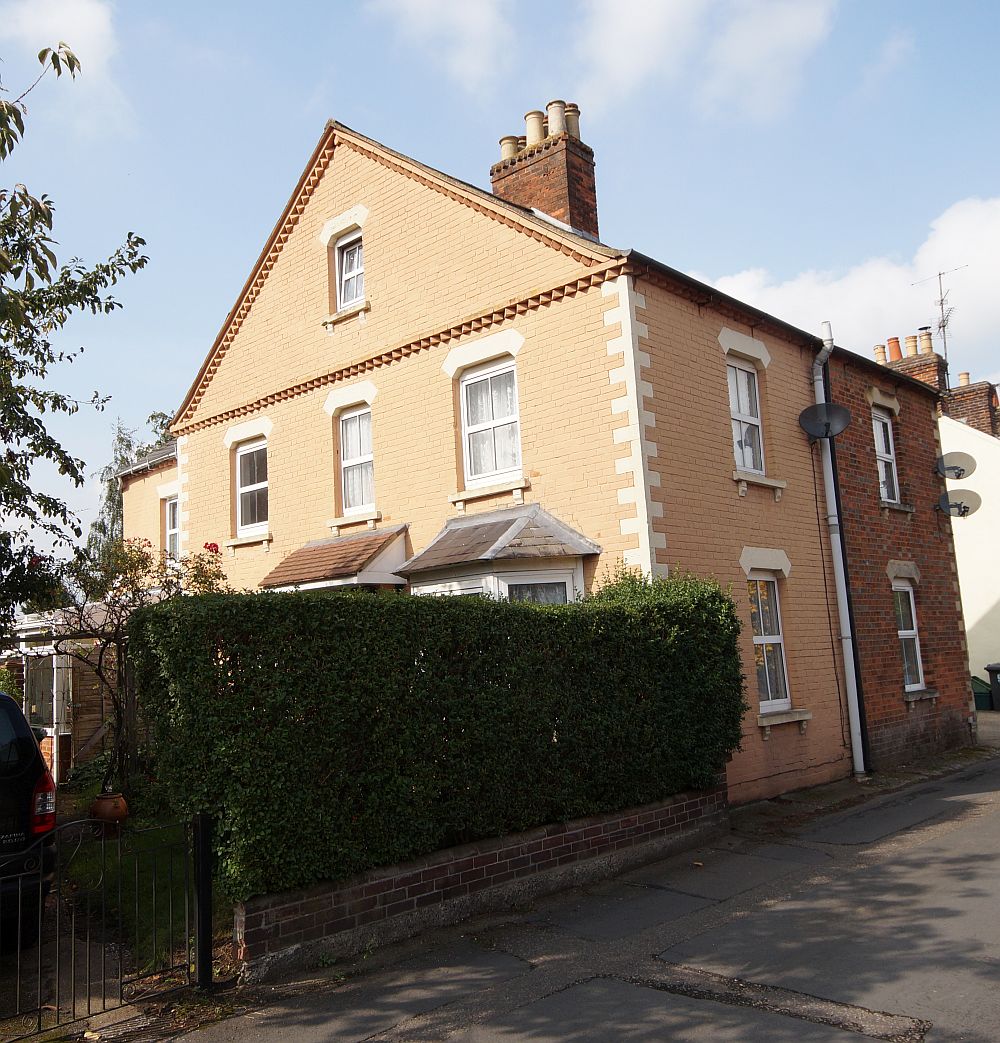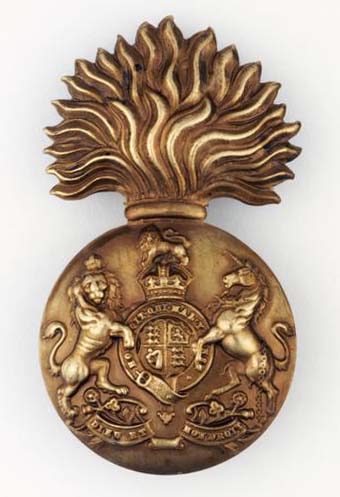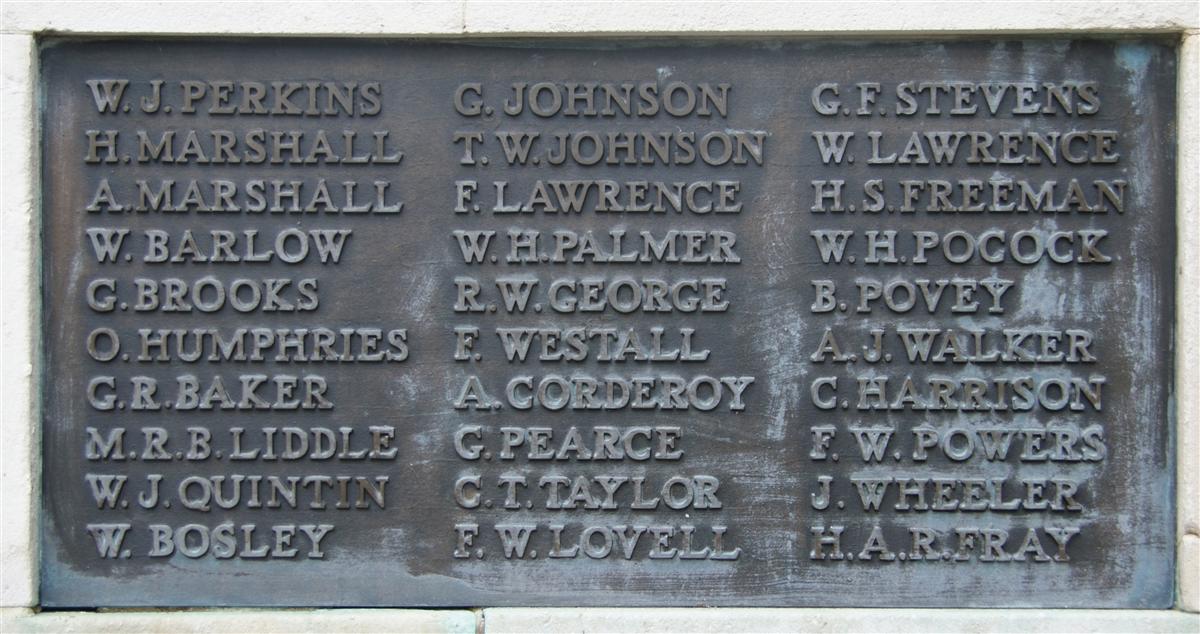George Johnson
Private 8031 George Johnson, 1st Battalion, Royal Scots Fusiliers 1st Bn.
George was born in Charney Bassett (then Berkshire, now Oxfordshire) on, according school records, 10 August 1886, the actual date of his birth was probably some months later. He was the illegitimate son of Jane Breakspear; his name was registered as George Thomas Johnson Breakspear in early 1887. The third forename is a pretty clear indication of his father’s surname! Jane had another illegitimate child, Sarah Maud (known as Maud) on 12 December 1885 (also from school records) – which is too close to the stated date of George’s birth, which was registered in early 1887. Parents would sometimes ‘adjust’ their child’s birth date in order to get them into school a few months earlier, an August birth date would allow the child to start in the winter term. Whilst it could be Maud’s birth date that is mis-stated in the school records it is less likely as the date given is consistent with the registration of her birth in the first quarter of 1886.
Two years after George’s death his mother married George Johnson; henceforth George and Maud would be known as Johnsons (though Maud had to use her official name when her marriage to Albert Carter was registered in 1908). It is almost certain that George Johnson was the father of both Maud and George – Jane having applied for a bastardy (child support) order against him following the birth of Maud.
The newly married couple soon had more children and over time produced another ten – four of whom died in infancy. The full list of those who survived until the 1911 census is: Maud, George, Charles Frank (born 1890), James Thomas (1893), Thomas William (1897), William Robert (1899), Lilian May (1902) and Gladys (1906). The lost infants were James William (1891-1891), Lydia Jane (1894-1894), Richard William (1895-1895) and Frederick (1901-1901).

1 Hampton Villas today - home to the Johnson family for much of the war. |
Records for some Newbury schools have survived and show several of the Johnson children entering and leaving St Nicolas’ National School. Rather strangely they rarely stay long – George arrived at St Nic’s from St John’s Infant School on 14 March 1894 and left six months later on 21 September. His brothers Thomas and William had even shorter stay of only three weeks in 1907. Maud had two spells at the school. All this suggests that the family moved around – certainly they were in Faringdon for a few years around the turn of the century, but some of the school departures cannot be explained in this way. For instance Tom and William both spent three weeks at St Nic’s in 1907, by which time the family had settled in Newbury for good, living in several properties in the York Road area. By 1914 they had moved to 1 Hampton Villas, Livingstone Road.
However, George was long gone by the time the war started. He joined the army, specifically the Royal Scots Fusiliers, when he was still a boy – his regimental number (8031) was issued in late 1903 or very early 1904. As a sixteen-year-old he could join as a boy soldier, but his service proper would not start until he was eighteen. On his eighteenth birthday he would have signed on as a Regular soldier for a term of twelve years. The first seven years would be spent ‘with the colours’ in uniform with one of his regiment’s battalions. After seven years he would have had the option to stay on to complete his twelve years or to return to England and civilian life while remaining a member of the Army Reserve undertaking only occasional training. George spent eight years in India so it is possible that he decided to serve out the 12 years in uniform, however, he was in England in 1914, not overseas with the regiment’s 2nd Battalion, so it is probable that he had left the army and was mobilised from the Reserve in 1914.
When war broke out on 4 August the British were committed to supporting their allies, France and Belgium, on the ground. To do this they mobilised troops stationed in the UK as a rapid response force, ready for deployment anywhere in the world they might be needed. By mid August troops of the British Expeditionary Force were landing in France under the command of Field Marshall Sir John French. The initial force consisted of two Corps each of two Divisions. The peacetime strength of the various units that comprised this force was well under its nominal fighting strength; to make up the numbers thousands of Reservists were used.
So George found himself wrenched from his peacetime life back into uniform and on to a boat bound for Le Havre where the 1st Battalion, Royal Scots Fusiliers landed on 14 August as a part of 9th Brigade, 3rd Division, II Corps.

The badge of the Royal Scots Fusilers © IWM (INS 5612). |
On 12 September the first British troops crossed the River Aisne; the Royal Scots Fusiliers crossed the following day; the battalion’s diary tells the story:
War Diary, 1st Battalion, Royal Scots Fusiliers – September 1914
13th Marched, 8th Bde leading. On approaching VAILLY, firing commenced. No casualties in spite of heavy shell fire. The canal & railway bridges over R AISNE had been broken by the enemy, so that we did not cross till 1am & billeted in rubber factory in VAILLY.
14th Ordered to march. A & D Coys ordered to support LINCOLNS at ORME. The advance was made over turnip fields and Coys were exposed to enfilade fire from Machine Guns. Capt BRIGGS ordered his Company to retire gradually and during retirement he was killed. We had no support from Arty. During the retirement Capt MILLER was hit in the chest. B & C Coys under Maj FORBES were ordered to support the 5th Fus’s on their right. 2nd Lt BETHELL was hit in the foot. Total casualties 8 killed, 69 wounded, 90 missing.
15th 5.00am The Bn took up part of the defensive line between the 5th and 7th Fus’s, with 1 Coy local Rserve. Arty duel continued all day but not Infy advanced. Worked on trenches at night up to 11pm as any work by daylight attracted fire. Enemy opened heavy Arty and rifle fire on the the position at 11.30pm & we quite epected to be attacked, but they made no further advance.
16th Arty (German) opened fire early in the morning & continued most of the day, and worked all night on the trenches. Very cold & wet.
17th Heavy artillery fire all day, trenches greatly improved during the night up to 2am. Rain all day and very cold.
Although the French and British crossed the river they were unable to make sufficient progress against prepared German positions along the ridge known as the Chemin des Dames. As a result they dug in to protect against German fire and remained pretty much where they were for almost four years. Trench warfare had reached the Aisne and, for the first time, the British.
George was killed during this battle; officially on 17 September. The war diary does not record any casualties on that day, but ‘Heavy artillery fire all day’ would usually result in some losses, especially in the makeshift trenches they would have had at that point. However, there is some confusion arising from the comment in his brother’s obituary (below) that he ‘was reported missing at Mons’. It is possible that he was wounded and taken prisoner at Mons, but this would usually mean that his subsequent death would be followed by burial in a known location, possibly followed by re-interment in an Imperial (later Commonwealth) War Graves Commission cemetery. His death in captivity would also generate paperwork – which would in time notify the British authorities of his date of death. However, the British recorded his death in the Soldiers’ Effects Register as ‘on or since’ 17 September 1914, a clear sign that he went missing (last seen on that date) and that no further news was received.
The activity from Mons to the Aisne all happened in a short period and merged in the public consciousness – the most likely scenario for his death is that he fell victim to a large shell that entirely obliterated him.
 George's name on Newbury War Memorial. (top centre) |
Locally he is remembered on Tablet 5 of the Newbury Town War Memorial.
Family
As noted in the newspaper item on Thomas’ death four of his brothers also served in the army during the war.
Charles began the war in Gibralter where his battalion, the 2nd Royal Scots Fusiliers, was stationed. It was soon recalled to the UK where it became a part of the 7th Division, which landed in France in October 1914 just in time to play a key role in preventing the Germans from outflanking the French around Ypres. He was probably a part of one of the battalion’s machine gun sections and was transferred to the Machine Gun Corps after it was formed in 1916. However, he may have responded to a call for volunteers to join a new branch of the service – the Heavy Branch of the Machine Gun Corps. These were the men who would enter history at Flers on 15 September 1916 crewing the first tanks. The names of most of the crews at Flers are known, and Charles was not among them, but he was probably in action before the end of the Battle of the Somme in November. He was wounded at some point, probably by the end of 1916, and was invalided out of the army on 28 April 1917. Whilst it would often be immediately obvious that a man would be of no further use to the army they would not usually be discharged before medical treatment had stabilised their condition and they were fit to go home. In time he was able to work as a gardener. It is thought, but not confirmed that he died in the 1950s.
James was the brother who served with the Berkshire Yeomanry at Gallipoli and then in the Camel Corps during the Palestinian campaign (perhaps getting the opportunity to meet Thomas before he died). He survived the war and returned to Newbury where he too worked as a gardener. In 1934 he married Elsie Gilder (formerly Watts) a widow; the couple raised a family in Newbury where James died in 1963 aged 70.
Thomas died in November 1917 in the third and final battle for Gaza in Palestine – his story is told here.
The final brother to serve was William, whose service with the Royal Army Medical Corps had proved impossible to isolate as there were numerous William Johnsons in the RAMC.

Find a memorial :
| Died this day: | |
| 15 January 1943 | |
| L C Lawrence | |
| Newbury |

Like this site? Show your appreciation through a donation to a great charity.